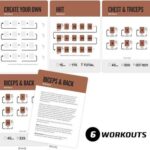Customizing Your Barbell Exercise Cards For Specific Fitness
Figuring out what you want from your fitness journey is the first big step. Whether it’s building muscle, boosting endurance, or torching calories, it’s all about setting clear goals. Identifying different end goals, such as strength for lifting heavier weights or hypertrophy for muscle growth, helps you tailor your barbell strategy to perfectly fit your desires.
Barbells are the backbone of many fitness routines. They are highly adaptable and ideal for building strength with resistance while also being adjustable to align with your specific goals. Whether you’re gunning for bigger biceps or a leaner physique, the right barbell exercises can make a big difference in hitting those targets.
It’s crucial to know exactly where you currently stand in terms of fitness. It means assessing your strength level, endurance capacity, and overall physical condition. Being realistic here provides a solid foundation for building your barbell workout plan. This way, you can tailor your exercises to fit what you’re currently capable of while still challenging yourself to improve.
Barbell exercises work best when they’re part of a broader workout routine aligned with your goals. Whether it’s paired with cardio for fat loss or integrated into high-intensity interval training for quick endurance boosts, barbell exercises need to complement other aspects of your fitness plan effectively. It’s all about harmonizing your workouts to make each routine effective and fun.
Designing Customized Barbell Exercise Cards

Creating barbell exercise cards can seem daunting, but they are an excellent way to keep your sessions focused and tailored to your personal fitness goals. These cards serve as your everyday workout blueprint, reminding you of the exercises, progression, and personalized process tailored just for you.
Having a mix of exercises that target different muscle groups is crucial when customizing your barbell exercise cards. Depending on whether you’re aiming for strength, endurance, or size, you’ll want to include different types of lifts. While squats, deadlifts, and bench presses are key for strength development, it’s essential to consider the advantages of including more specialized exercises in your workout regimen.
A well-structured routine will make or break your progress. Consider the number of sets, repetitions, and rest periods, as these should align with your goals. For strength, fewer reps at higher weights come into play, while endurance might call for more repetitions with less weight. Planning is key, so set your progression and periodically tweak your plan as you improve.
Tech can be your best friend here. From simple apps that track your workout history to more sophisticated software that suggests changes based on your progress, there’s plenty of assistance available. These tools can help you keep your exercise cards fresh and practical, ensuring you’re always moving towards those fitness goals.
Incorporating Safety and Form in Barbell Training
When it comes to barbell exercises, form is your best friend. Maintaining proper technique isn’t just about preventing injuries; it’s also about getting the most out of each lift. Improper form can lead to strain or even serious injury, so keeping a close eye on your posture and movement is essential.
Avoiding common mistakes is easier with a bit of knowledge and mindfulness. Rushed reps, lifting more than you should, or neglecting warm-ups are pitfalls that can sideline your progress. Taking the time to position yourself for each exercise and warm up properly will go a long way in keeping you on track.
Spotting for barbell exercises, when done right, can be a valuable safety net. Even if you’re training solo, learning to self-spot can be a game changer. Mirrors, wearables, or even setting up your camera can help you maintain form and spot errors before they lead to problems.
It’s crucial to balance intensity with safety. Knowing your limits and being realistic about your capabilities is vital. Pushing too hard might yield quick gains, but it can also end in burnout or injury. Listen to your body, and don’t be afraid to scale back the weight until you’re confident in your form and technique.
Measuring Progress and Adapting Your Barbell Routine
Tracking your progress is like keeping a scorecard for your goals. It’s about more than just lifting more weight; it’s seeing improvements in strength, endurance, or muscle mass over time. Record your stats and celebrate those small victories—they add up over months of hard work.
As you progress, there’ll come a point where you’ll need to tweak your exercise cards. Whether it’s increasing the weight, changing rep schemes, or introducing new exercises, adapting your plan keeps those gains coming and prevents plateaus. Making the proper adjustments is key to staying challenged and motivated.
Hearing true success stories can be profoundly motivating and uplifting. They offer proof that customized barbell routines do work wonders, transforming not just bodies but overall fitness levels. Use these testimonials as motivation or even to get new ideas for mixing things up in your routine.
Feedback, whether from a trainer or self-evaluation, plays a significant role in personalizing your workout. It keeps you aware of your body’s response and highlights areas needing improvement. Making small changes based on feedback keeps your routine dynamic, effective, and enjoyable.
